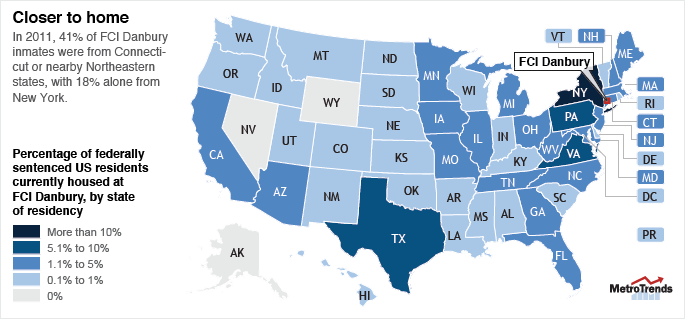
Yesterday, the Federal Bureau of Prisons (BOP) decided to allow female prisoners who hail from the region surrounding the Danbury Federal Correctional Institution to remain at the facility, where a new prison will be built to house the growing population. The decision is being heralded as a welcome reversal—and rightly so. Our analysis shows that 41 percent of women housed in Danbury—a location familiar to fans of Piper Kerman’s memoir and the popular Netflix series, Orange is the New Black—live in Connecticut or nearby northeastern states from Pennsylvania through Maine.
Why does proximity to home matter? Distance from prison is the greatest barrier to maintaining contact with family and loved ones during incarceration.

Keeping in touch with family is a critical component of successful reentry. Our research has found that families are an important influence on the reentry process, with higher levels of family support linked to higher employment rates and reduced recidivism following release.
But the positive role that families can play is dependent on the degree of contact they have with their incarcerated loved ones. In-prison contact with family members leads to closer family relationships following release. Such contact allows parents to maintain connections with their children, which in turn encourages them to keep their lives on track upon release. This could yield major benefits, as the research shows exiting prisoners with strong, positive relationships with their children tend to be legally employed for longer periods than those who have weaker ties to their kids. The decision to keep more women housed in Danbury increases the odds that they can enjoy visits from family and remain engaged in their children’s lives.
But it is still worth examining why the BOP was considering a policy that runs so contrary to evidence-based practice. This is a direct result of dangerous overcrowding in federal prisons and the increasing cost of maintaining a growing prison population. Currently, high-security prisons are operating at over 50 percent of their rated capacity, putting correctional officers and prisoners alike at increased risk of violence and restricting the ability to offer much needed programs and treatment to support successful reentry.
At the same time, there’s not enough money in government coffers to build the prisons required to meaningfully reduce overcrowding. Increasing BOP budgets have already crowded out other federal spending priorities, compromising public safety in the process.
Our new report, Stemming the Tide, shows that it will take major policy changes to reduce federal prison overcrowding and forego the need to build more prisons. The BOP budget is already consuming an increasing share of Department of Justice resources at great expense to other important safety priorities.
The decision to build a new prison for women in response to the Danbury controversy is addressing the symptoms, not the underlying causes of the problem: decades of lengthy sentences for drug offenders, even those who are non-violent or do not use weapons. Indeed, 85 percent of the women housed at the Danbury facility do not have a violent or weapons-related most serious offense, and 57 percent are drug offenders.
So while our research supports keeping local women housed at Danbury, it also suggests that a longer term solution to the problem is to rethink what got these women and many other low-level drug offenders there to begin with. Reducing mandatory minimums and truth in sentencing caps and increasing access to programming and early release credits for participating in them would go a long way toward addressing the problem. These strategies can reduce overcrowding and keep women out of prison altogether, allowing them to serve out their sentences close to home and family.
Statistics come from Urban Institute analysis of Fiscal Year 2011 Bureau of Prisons data.
Let’s build a future where everyone, everywhere has the opportunity and power to thrive
Urban is more determined than ever to partner with changemakers to unlock opportunities that give people across the country a fair shot at reaching their fullest potential. Invest in Urban to power this type of work.